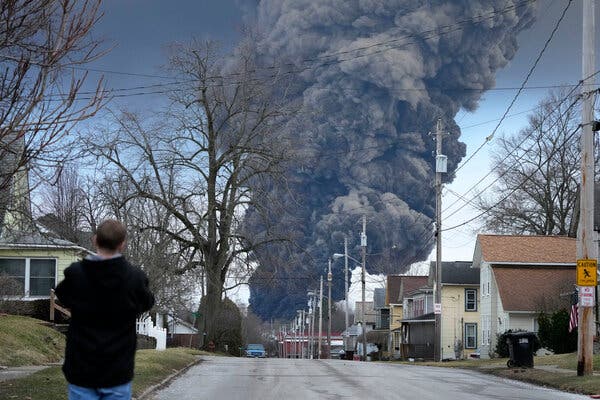Months-Long Persistence Of Toxic Chemicals After Ohio Derailment

Table of Contents
The Nature of the Persistent Chemicals
Identifying the Toxic Substances
The Ohio derailment released a cocktail of hazardous chemicals, many known for their persistence in the environment and potential for long-term health impacts. Key among these are vinyl chloride and butyl acrylate.
-
Vinyl Chloride: A colorless gas used in the production of PVC plastics, vinyl chloride is a known carcinogen. It is highly volatile but can persist in soil and groundwater, especially in anaerobic conditions. Studies show its half-life in soil can range from weeks to months, depending on factors like soil type and temperature. Inhalation can cause dizziness, headaches, and potentially more severe respiratory issues.
-
Butyl Acrylate: This colorless liquid is used in the production of paints, adhesives, and coatings. While less volatile than vinyl chloride, butyl acrylate can persist in soil and water. It's known to irritate the skin, eyes, and respiratory system and can have adverse health effects through inhalation or dermal contact. Its environmental persistence depends on factors including soil composition and microbial activity.
-
Other chemicals released, though potentially less persistent, also add to the overall toxic burden and demand careful monitoring. The complex mixture necessitates a multi-faceted approach to assessment and remediation.
Extent of Environmental Contamination
Water Contamination Analysis
Local water sources, including groundwater and surface water (like the Ohio River), have shown evidence of contamination. Initial tests revealed elevated levels of vinyl chloride and other contaminants exceeding safety thresholds set by the EPA.
- Ongoing water testing programs are crucial for tracking the extent and spread of contamination.
- The potential for long-term contamination of drinking water supplies poses a significant risk to public health.
- Detailed analysis is needed to understand the pathways of chemical migration and the long-term impact on aquatic ecosystems.
Soil Contamination Assessment
Soil samples collected near the derailment site show significant contamination with vinyl chloride, butyl acrylate, and other chemicals. The concentrations vary depending on proximity to the derailment site.
- The high concentration of chemicals in the soil poses risks to both human health and the environment.
- There's a significant concern about leaching of these contaminants into groundwater, potentially contaminating drinking water sources for years to come.
- Long-term monitoring of soil conditions is essential to assess the effectiveness of remediation efforts.
Air Quality Impacts
While the immediate, acute air quality issues have subsided, the potential for long-term respiratory problems remains. Initial air quality monitoring indicated elevated levels of various volatile organic compounds (VOCs).
- Long-term monitoring is necessary to assess potential for chronic respiratory issues among residents.
- The impact on sensitive populations, such as children and the elderly, requires particular attention.
- Further research is needed to fully understand the lingering effects of airborne contaminants on human health.
Long-Term Health Risks and Impacts
Human Health Concerns
Residents of the affected area face potential long-term health consequences from exposure to the toxic chemicals. Reports of respiratory problems, skin irritation, and headaches have emerged.
- Ongoing epidemiological studies are crucial for assessing the long-term health impacts of the derailment.
- Access to comprehensive healthcare and ongoing medical monitoring for affected residents is essential.
- Public health authorities need to proactively address potential long-term health concerns, providing information and support to the community.
Wildlife and Ecosystem Effects
The derailment's impact extends beyond human health, affecting local wildlife and ecosystems. Reports of dead fish and other wildlife have been documented.
- The long-term effects on biodiversity and ecosystem health need further investigation.
- Monitoring the health of local wildlife populations is essential to assess the extent of environmental damage.
- Remediation efforts must consider the impact on the entire ecosystem, not just human health.
Cleanup Efforts and Ongoing Challenges
Remediation Strategies
The cleanup involves various methods, including excavation of contaminated soil, the use of activated carbon to absorb chemicals from water, and air filtration systems.
- The effectiveness of these methods in addressing the persistent nature of the chemicals remains to be fully evaluated.
- The scale of the cleanup presents significant logistical challenges.
- The cost of remediation is substantial, raising questions about funding and responsibility.
Regulatory Oversight and Accountability
Regulatory agencies are overseeing the cleanup process and conducting investigations to determine the cause of the derailment and to hold responsible parties accountable.
- Increased transparency and accountability are crucial to ensure effective remediation.
- Strengthening regulations regarding the transport of hazardous materials is paramount.
- The incident highlights the need for a more robust system for preventing and responding to similar events.
Conclusion
The months-long persistence of toxic chemicals following the Ohio derailment underscores the significant and ongoing environmental and health risks. The complexities of the cleanup, the potential for long-term contamination, and the need for extensive monitoring highlight the seriousness of the situation. The persistent presence of these toxic chemicals demands ongoing vigilance, comprehensive cleanup efforts, and rigorous long-term monitoring to mitigate the lasting effects of the Ohio derailment. We need continued public pressure to ensure complete remediation and protect the health and well-being of affected communities. Stay informed about the latest developments concerning the persistence of toxic chemicals after the Ohio derailment.

Featured Posts
-
 Niftys Strong Performance Analyzing The Market Buzz In India
Apr 24, 2025
Niftys Strong Performance Analyzing The Market Buzz In India
Apr 24, 2025 -
 Cassidy Hutchinson Key Witness To Publish Memoir On January 6th Hearings
Apr 24, 2025
Cassidy Hutchinson Key Witness To Publish Memoir On January 6th Hearings
Apr 24, 2025 -
 Your Guide To Private Credit Jobs 5 Dos And Don Ts For Getting Hired
Apr 24, 2025
Your Guide To Private Credit Jobs 5 Dos And Don Ts For Getting Hired
Apr 24, 2025 -
 The Impact Of Us Tariffs Chinas Increased Lpg Imports From The Middle East
Apr 24, 2025
The Impact Of Us Tariffs Chinas Increased Lpg Imports From The Middle East
Apr 24, 2025 -
 Nancy Mace Faces Public Confrontation Reactions And Analysis
Apr 24, 2025
Nancy Mace Faces Public Confrontation Reactions And Analysis
Apr 24, 2025
